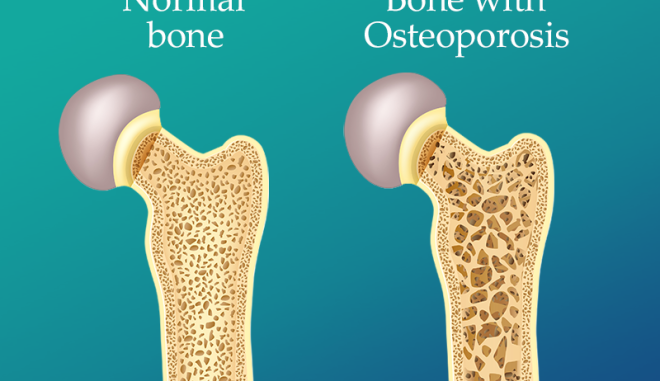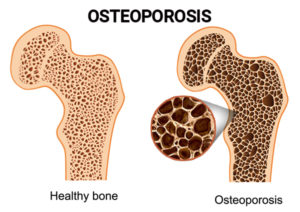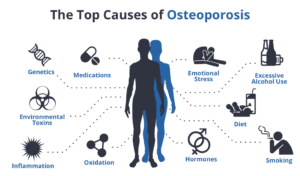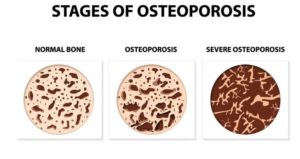
Table of Contents
What is Osteoporosis?
- The word ‘Osteoporosis’ means ‘porous bone.’
- Osteoporosis is a condition that is characterized by low bone mass, degradation of bone tissue, and disturbance of bone microarchitecture.
- It is a condition where the bone strength becomes weak and increases the risk of fractures.
- Osteopororis develops when more bone is broken down than replaced.
- Osteoporosis is also referred to as “silent sickness” due to condition in which a person may not notice any symptoms until a bone fractures, typically a bone in the hip, spine, or wrist.
- Osteoporosis is a condition that makes bones weak and brittle, so fragile that even minor stressors like coughing or bending over can break them.
- Bone is a living tissue that undergoes continuous deterioration and replacement. When the production of new bone is inadequate to compensate for the loss of existing bone, osteoporosis develops.
Key Facts
- Osteoporosis is the most common bone disease in humans, and it is a huge public health issue.
- During osteoporosis, the inside of a bone looks like a honeycomb.
- Osteoporosis means that a person has less bone mass and strength.
- Similar to how hypertension raises the risk of stroke, osteoporosis does the same for fractures.
- People of all sexes and races are affected by osteoporosis in large numbers, and as the population ages, this prevalence will rise.
- Until fractures happen, a silent disease which then result in serious secondary health issues or even death.
- There are more than 200 million people with osteoporotic hip fractures globally, according to estimates.
- One in every two women and one in every four males will get an osteoporosis-related fracture after the age of 50.
- Another 30% of people have low bone mass, which increases their risk of osteoporosis. The name of this condition is osteopenia.
Causes of Osteoporosis
- Osteoporosis is caused by a reduction in bone density, which makes bones weaker and easily shattered. Everyone loses bone density as they age, but for some people, this loss happens too quickly.
- If a risk factor is present, the likelihood of developing osteoporosis increases. Some risk factors, like age, cannot be modified, while others, like lifestyle modifications or drugs, can be minimized.
Symptoms of Osteoporosis
- Vertebral fracture or collapse resulting in back pain
- Height decline with time
- A hunched position
- A bone that fractures far more quickly than is typical
Risk factors
1. Non- modifiable risk factors
It includes:
- Age: Risk rises in the mid-30s, especially after menopause.
- Reduced sex hormones: Less estrogen seems to make bone regeneration more difficult.
- Ethnicity: Compared to other ethnic groupings, white people and Asians are at a higher risk.
- Height and weight: Possessing a height of over 5’7″ or weighing less than 125 pounds increases risk.
- Genetic factors: Osteoporosis is more prevalent if a close relative has been diagnosed with a hip fracture or the disease.
- Previous fractures: People over 50 who have experienced fractures following minor injuries are more likely to be given an osteoporosis diagnosis.
2. Modifiable risk factors
It includes inactivity and immobility. Exercise using weights can help prevent osteoporosis. It applies the bones to regulated stress, which promotes bone formation.
3. Other risk factors
- Poor dietary habits, mainly the deficiency of calcium, Vitamin D and protein
- Family history of osteoporosis
- Use of alcohol
- Smoking
- Long term use of medications
Who is at Risk of Osteoporosis?
Medical conditions that raise the risk are:
- Some autoimmune diseases, like rheumatoid arthritis and ankylosing spondylitis
- Adrenal gland disorders
- Pituitary gland issues
- Hyperthyroidism and hyperparathyroidism
- Deficiencies in estrogen or testosterone
- Issues with mineral absorption, like celiac disease
People who use certain medication are also in risk of this disease. The medications include:
- Anticoagulants and blood-thinners, such as heparin and warfarin
- Thyroid hormone
- Protein-pump inhibitors (PPIs), and other antacids that negatively affect mineral status
- Antidepressant
- Vitamin A (retinoid) medications
- Thiazide diuretics
- Thiazolidinedione, which is used to treat type 2 diabetes
Diagnosis of Osteoporosis
- Bone density assessment by DXA at the hip and spine is regarded as the most accurate method for detecting osteoporosis and estimating the risk of fracture.
- Some persons get peripheral DXAs, which assess the wrist and heel bone densities. The portability of this DXA type may make screening simpler.
Complications
- Osteoporosis frequently goes unnoticed until a bone breaks and you experience discomfort. In comparison to regular low back pain, bone pain is said to be more acute.
- Osteoporosis-related fractures can result in balance issues that raise the risk of falls and subsequent fractures.
- When osteoporosis-related fractured bones mend, the joints can soon develop arthritis, increasing pain and necessitating medical attention.
- Sometimes, because of osteoporosis, the spinal cord or nerves that leave the spine get crushed or inflamed, resulting in additional discomfort and dysfunction.
- Vertebral compression fractures (VCF) are osteoporosis’ most frequent consequence
- An increased chance of falling and breaking a hip or other bone can result from spinal compression fractures, which can make it difficult to walk and/or cause balance problems.
Prevention
- Diet – An ideal diet for bone health entails getting adequate protein, calories, calcium, and Vitamin D, all of which are crucial for maintaining healthy bone development and density.
- Exercise – Exercise can lower the risk of fracture by increasing bone mass in premenopausal women and maintaining bone density in postmenopausal women.
- Smoking – Smoking is known to hasten bone loss, hence it is strongly advised to avoid or quit for the sake of bone health.
- Avoiding falls – Older persons who fall dramatically increase their risk of osteoporotic fractures. By taking steps to avoid falls, the chance of fractures can be reduced.
Rehabilitation
- Orthopedic rehabilitation, physical therapy, occupational therapy, nutrition counseling, and other specialized treatments are frequently used in osteoporosis rehabilitation to effectively manage the condition and enhance quality of life.
Treatment of Osteoporosis
- Usually, the first line of treatment for osteoporosis is isphosphonates. These consist of:
- Alendronate, a weekly medication (Fosamax)
- A weekly or monthly tablet called Risedronate (Actonel)
- Monthly pills or quarterly intravenous (IV) infusions of ibandronate (Boniva)
- An annual IV infusion of zoledronic acid (Reclast)
References and For More Information
https://www.ncbi.nlm.nih.gov/pmc/articles/PMC4064946/
https://asbmr.onlinelibrary.wiley.com/doi/full/10.1359/JBMR.040507
https://www.nhs.uk/conditions/osteoporosis/prevention/
https://www.healthline.com/health/osteoporosis-complications#complications
https://www.spineuniverse.com/conditions/osteoporosis
https://www.bonehealthandosteoporosis.org/pagets-symptoms/
https://www.mayoclinic.org/diseases-conditions/osteoporosis/diagnosis-treatment/drc-20351974
https://www.radiologyinfo.org/en/info/osteoporosis


